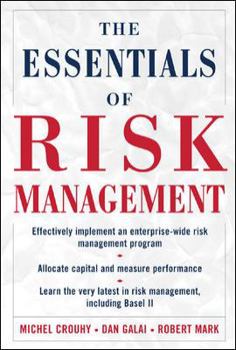The Essentials of Risk Management
Select Format
Select Condition 
Book Overview
The definitive guide to quantifying risk vs. return--fully updated to reveal the newest, most effective innovations in financial risk management since the 2008 financial crisis Written for risk... This description may be from another edition of this product.
Format:Hardcover
Language:English
ISBN:0071429662
ISBN13:9780071429665
Release Date:December 2005
Publisher:McGraw-Hill
Length:414 Pages
Weight:1.67 lbs.
Dimensions:1.3" x 6.2" x 9.0"
Customer Reviews
5 ratings
Risk Management
Published by Thriftbooks.com User , 14 years ago
Great book to get introduced to risk management. Easy reading and comprehensible, without all the math formulas some other authors include. Have used it often in my consulting work! Highly recommended also for beginners and all interested in risk management, a good re-fresher!
Review
Published by Thriftbooks.com User , 16 years ago
I hold a Masters Degree in security management and am pursuing certification as a risk management professional. This book was recommended by a specialized major trade association. At this oint, I'm only part way through the book, but I can assure any interested party that the book is well worth the investment.
Associate PRM Certificate Exam Registration
Published by Thriftbooks.com User , 16 years ago
The Associate Professional Risk Manager (PRM) is a new PRMIA certificate program intended for staff entering the risk management profession, or those who interface with risk management disciplines on a regular basis, such as auditing, accounting, legal, and systems development personnel who want to understand fundamental risk management methods and practices. Designed to be mathematically and theoretically less detailed than the Professional Risk Manager (PRM(tm)) certification, the new program will cover the core concepts allowing non-specialists to interpret risk management information and reports, make critical assessments and evaluate the implications and the limitations of such results.
An excellent introduction
Published by Thriftbooks.com User , 18 years ago
This book provides an introduction to the field of risk management for readers who do not yet want to get deeply involved in the mathematical formalism that is typically used. The authors wrote the book so that it is "accessible to everyone", and they have done a fine job. Those readers who need a more quantitative treatment will have to consult another book or the vast research literature on the subject. Risk management, as they see it, is an attempt to estimate both the `expected' losses and the `unexpected' losses, and being able to differentiate between these two concepts goes to the core of the subject. Thus the book emphasizes the "intuition" behind risk management, and not the formalism. However, one must not conclude from this that "intuition" and "formalism" are distinct, and the belief that they are has resulted in a lot of confusion (and financial losses) in recent years. The authors clearly do not believe that they are, but have merely emphasized "intuition" from a pedagogical point of view. The authors classify risk into eight categories, namely market, credit, liquidity, operational, legal and regulatory, business, strategic, and reputation risk. Financial risk, as they see it, is composed of two of these, namely market and credit risk. Their discussion of corporate risk management is very interesting, in that it begins with the observation first made almost forty years ago that the value of a firm is not altered solely by financial transactions. This is due to their assumption of the perfect market hypothesis, which effectively suppresses the ability of the firm to gain significant advantages over an individual investor. Therefore with this assumption a firm should not concern itself with risks outside of the ones that all other firms face. This is an interesting conclusion, particularly in the context of using hedging via derivatives, as it implies that it cannot compete with ordinary self-insurance, due to the presence of transaction costs. The authors discuss in fair detail why the perfect market assumption is faulty, and therefore why managing risk with hedging is a viable strategy. The regulatory environment, particularly in the banking industry, has enormous ramifications for risk management, as the authors discuss in the book. This is due in part to the Basel Accords of 1988 and 1996, and Basel II which is due to be in place at the end of 2007. The Basel accords are essentially a standardization for capital reserves, defining a `assets-to-capital' multiple and a `risk-based capital' ratio. The authors review the 1988 Accord and discuss the elementary relationships involved, including the `Cooke ratio' and how to obtain the credit equivalent for the off-balance-sheet exposures. They also discuss the reasons for the 1996 amendment, which essentially were the result of the new trading activities that banks were indulging themselves in. It would have been interesting if the authors had included a (historical) discussion on t
A Non-Mathematical Approach
Published by Thriftbooks.com User , 18 years ago
The essense of investing is that increased risk should be compensated for by increased return. The problem lies in measuring and thus managing risk. Measuring risk is in the same category as predicting the future. The future is uncertain, the best guesses fail as bad weather, oil embargoes, or any of a whole list of other incidents change the situation. Risk management isn't simply a matter of avoiding risk. It is instead a matter of identifying it, measuring it, appreciating its consequences and then taking actions accordingly. Insurance is perhaps the best example. If a hundred sailing ships go out and 90 return, spreading the risk among all hundred ships compensates for the loss of the ten. And Lloyds is born. During recent years several techniques have been developed to measure risk. This book discusses them in a non-mathematical way that can be used by both risk and non-risk professionals. In essence it brings sophisticated techniques to be accessible to a wide audience.






